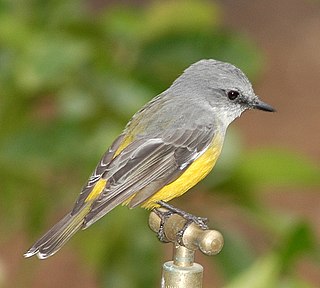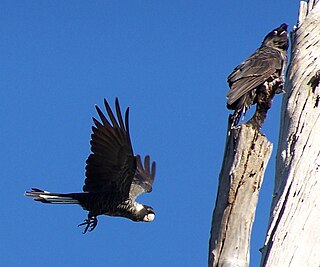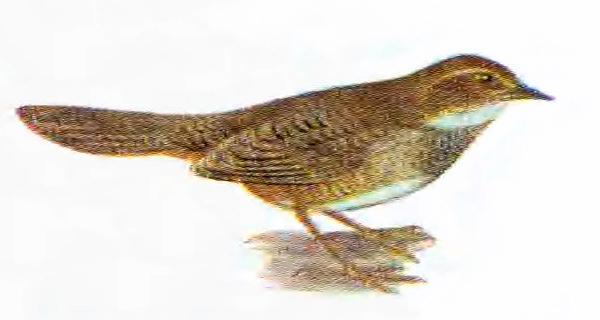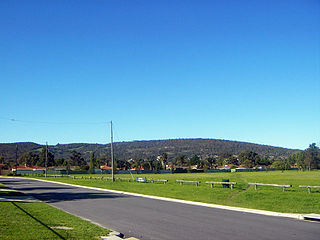
Kalamunda National Park is a national park in Western Australia, 23 kilometres (14 mi) east of Perth, near the town of Kalamunda.

Moora is a townsite located 177 km north of Perth in the Wheatbelt region of Western Australia. Moora was one of the original stations on the Midland railway line to Walkaway, and the townsite was gazetted in 1895. At the 2006 census, Moora had a population of 1,822.

Baudin's black cockatoo, also known as Baudin's cockatoo or long-billed black cockatoo, is a species of genus Calyptorhynchus found in southwest Australia. The epithet commemorates the French explorer Nicolas Baudin. It has a short crest on the top of its head, and the plumage is mostly greyish black. It has prominent white cheek patches and a white tail band. The body feathers are edged with white giving a scalloped appearance. Adult males have a dark grey beak and pink eye-rings. Adult females have a bone coloured beak, grey eye-rings and ear patches that are paler than those of the males.

Calingiri Important Bird Area is an 807 km2 tract of land roughly centred on the town of Calingiri in the Wheatbelt region of Western Australia. It lies about 120 km north-east of Perth. It has been classified by BirdLife International as an Important Bird Area because it supports up to 20 breeding pairs of short-billed black cockatoo, an endangered species that nests in remnant patches of eucalypt woodland and isolated paddock trees, and feeds in native shrublands. The area also supports the restricted-range western corella and a globally important population of the western yellow robin.

Cataby Important Bird Area is a 314 ha tract of land lying about 2 km south of the town of Cataby, adjacent to the Brand Highway, in the Wheatbelt region of Western Australia. It has been classified by BirdLife International as an Important Bird Area (IBA) because it supports up to 24 breeding pairs of short-billed black cockatoo, an endangered species that nests in remnant patches of eucalypt woodland and isolated paddock trees, and feeds in native shrublands. The area also supports the restricted-range western corella and a globally significant population of the regent parrot.

Gidgegannup Important Bird Area is a highly fragmented tract of land, where the fragments are patches. of remnant native vegetation, bounded by a circle roughly 12 km in diameter. It is in south-western Western Australia about 30 km north-east of Perth and on the dge of the Perth suburban region. The towns of Gidgegannup and Parkerville lie on the periphery. It has been identified by BirdLife International as an Important Bird Area (IBA) because it supports at least 450 Baudin's black-cockatoos, as well as small numbers of Carnaby's black-cockatoos, in roost sites outside the breeding season within foraging range of feeding habitat. The IBA also supports red-capped parrots, rufous treecreepers, western spinebills, western thornbills and western yellow robins.

Gillingarra Important Bird Area is an 83 km2 tract of land in the wheatbelt region of Western Australia. It is located near Mogumber and Koogan on the former Midland Railway line.

Jalbarragup Important Bird Area is a 258 km2, fragmented tract of land. It comprises the blocks of native vegetation of more than 1 ha on private land, water catchment areas, state forests, nature reserves and other reserves within a ten-kilometre radius of Jalbarragup in the shire of Nannup, south-west Western Australia. The area has a Mediterranean climate.

The Koobabbie Important Bird Area comprises several disjunct, mostly linear, patches of land with a collective area of 254 ha. It lies in the northern wheatbelt region of Western Australia, about 20 km south-east of Coorow. It consists of remnant salmon gum woodlands on the Koobabbie farming property that provide the nesting habitat of large tree hollows necessary for breeding cockatoos.

Moora Important Bird Area comprises a fragmented area of 685 ha centred on the rural township of Moora, in the wheatbelt region of south-west Western Australia. It lies about 175 km north of Perth. Most of the site is private land.

The Natimuk-Douglas Wetlands comprise a chain of freshwater, brackish and saline wetlands in the semi-arid Wimmera region of western Victoria. Australia. They are important for waterbirds.

North Dandalup Important Bird Area comprises a highly fragmented 76 km2 tract of land lying about 50 km south of Perth in the Peel region of south-west Western Australia. It is named after the nearby small town of North Dandalup.

The Northern Swan Coastal Plain Important Bird Area comprises a 2307 km2 tract of land in south-west Western Australia.

The Lakes Important Bird Area comprises some 72 km2 of land near the community of The Lakes in the Shire of Mundaring on the eastern fringe of the metropolitan area of Perth, Western Australia. It is an important site for the conservation of threatened Western Australian black cockatoos.

The Two Peoples Bay and Mount Manypeaks Important Bird Area is a 261 km2 tract of coastal and subcoastal land east of the city of Albany in south-west Western Australia. It is an important site for the conservation of several rare and threatened birds.

The Walebing Important Bird Area comprises a 13 km2 tract of land in the vicinity of the rural township of Walebing, in the northern whatbelt region of south-west Western Australia.

The Araluen-Wungong Important Bird Area is a 123 km2 tract of land in the Darling Ranges on the south-eastern fringe of the city of Perth, Western Australia. The name derives from the Araluen Botanic Park within the Important Bird Area (IBA) and the adjacent suburb of Wungong. It is an important site for black cockatoos.

The Bindoon-Julimar Important Bird Area is a fragmented 525 km2 tract of land in the northern Darling Ranges, of south-western Western Australia. It is about 5 km east of the town of Bindoon and 80 km north of Perth, on the edge of the wheatbelt. It lies between the Calingiri and Northern Swan Coastal Plain IBAs.



















